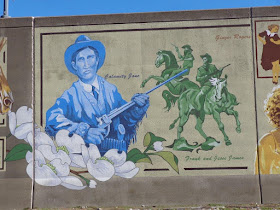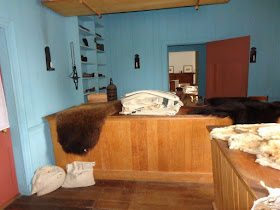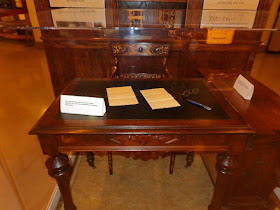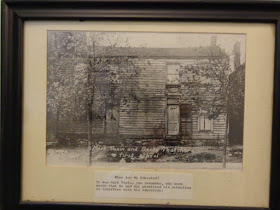Cape Giradeau is a small town on the Mississippi in southern Missouri. There is a flood wall along the town, but they have very nicely painted murals on it. In addition, you can walk though the opening to a very pleasant area along the river. It was a slightly cool, but very nice sunny day today, so sitting along the river on a bench was enjoyable.
This is the entrance to the riverside area. You can see the flood marks on here and on several places in town before the wall was built.
Nice view from here. Lots of places to sit and a walking/jogging trail.
I did not bother taking any photos of the town itself, but I found the wall very interesting. This section by the public parking lot shows all the famous people from Missouri. This is only a small sample.
I found this roadside park on my way to the Kentucky state park I was headed for. Nice view of the river. Just above here the Mississippi was joined by the Ohio River so it is a lot wider than farther north.
Saturday, October 31, 2015
Friday, October 30, 2015
10/28 Sainte Genevieve, MO
As you might have suspected from my recent posts, I am sticking close to the Mississippi and working my way south along what is called the Great River Road. The map below gives you an idea of the Road and the attractions along the way. I joined it in St. Louis, drove up to Hannibal, and am now headed south.
These signs tell you a little about the town. (I have to tell you that I could not stop mentally singing the song with the same name from the musical Camelot!)
This home on the corner is currently the offices of the Missouri Natural Resources. It also has a small gift shop and offers tours. Since this is very much off-season, I paid $4 and got my own personal tour of this house and two others across the street.
This was an elegant home of a prosperous family, as you can tell from this coal-burning fireplace.
Apparently, the lady of the house heard about a steamboat that had crashed on the nearby river, so she sent someone to rescue these original frosted glass panes for the door that divides the living room from the area that had originally been an office and store.
I was impressed with this original door. It had the original hardware and was at least 40" wide.
This is the kitchen and laundry for the front house with the offices. It was common to have those functions separate to keep smells and heat away from the main house, especially in the summer.

This is a store/residence across the side street. The stone is the native limestone that is mined nearby.
The downstairs looked like this.
Upstairs was much more elegant! It is furnished as it would have been in 1830.
The wash house in the back yard.
And a view of the back porch.
Just another interesting building in town.
Ste. Genevieve is an unusual small town along the river with two distinctions from most of the river towns:
- It is older than most, being founded in the early 1700s as a fur trading port.
- It has a lot of French influence, with a dab of Early American, as you can see from some of the houses below.
These signs tell you a little about the town. (I have to tell you that I could not stop mentally singing the song with the same name from the musical Camelot!)
This home on the corner is currently the offices of the Missouri Natural Resources. It also has a small gift shop and offers tours. Since this is very much off-season, I paid $4 and got my own personal tour of this house and two others across the street.
This was an elegant home of a prosperous family, as you can tell from this coal-burning fireplace.
Apparently, the lady of the house heard about a steamboat that had crashed on the nearby river, so she sent someone to rescue these original frosted glass panes for the door that divides the living room from the area that had originally been an office and store.
I was impressed with this original door. It had the original hardware and was at least 40" wide.
This is the kitchen and laundry for the front house with the offices. It was common to have those functions separate to keep smells and heat away from the main house, especially in the summer.

This is a store/residence across the side street. The stone is the native limestone that is mined nearby.
The downstairs looked like this.
Upstairs was much more elegant! It is furnished as it would have been in 1830.
The wash house in the back yard.
And a view of the back porch.
Just another interesting building in town.
And, to end my visit here, my "trusty" GPS that is supposed to guide me only on routes where I can take my large vehicle, instead took me down a road with a 9' clearance railroad underpass, so I had to back up through parked cars for at least 600 feet, and then back through a four-way stop!! Managed without hitting anything. I am getting much too good at this long backing up!! I was VERY glad to get out of town without any scratches or destroying anything.
Tuesday, October 27, 2015
10/26 Hannibal & Mark Twain/Sam Clemens
I am staying for a few days in a very nice Corps of Engineering (COE) campground on Mark Twain Lake. It is only about 25 miles from Hannibal, Missouri, Mark Twains boyhood home town, so I had to go there today. First stop was the museum to buy tickets for the rest of the attractions.
The museum did not look like much on the outside, but it was well done and had a lot of the author's belongings inside. Here is a dresser from his Connecticut home.
And what was described as his favorite desk.
This was interesting. It is a ship's whistle similar to the ones used on riverboats during Mark Twains time as a pilot. It operated with a bellows, so you pulled on the rope and got a satisfying sound!
In 1907, Twain was given a Doctor of Letters degree from Oxford University, so here is his academic regalia. One of the others who received a similar degree that day, as noted on the copy of the program, was Rudyard Kipling! Neat.
Hannibal's school no longer exists, but here is a photo of the one Twain attended until age 11, when his father died and his mother could no longer afford the 25 cents per week fee.
This is a real beaver top hat owned by Twain.
Down the street a couple of blocks to where the other attractions are all clustered on a side street.
The white house on the right was the Twain home for the first several years the family lived in Hannibal.
Across the street was his father's law office. Unfortunately, he never did well in business and his family got poorer and poorer, so he lost his office and then died when Twain was 11.
This is the side yard of the Twain home, looking across the street at the law office building and the drugstore to the left.
The drug store is important because the family had to move to the upstairs where they lived with another family as the family got poorer. His father worked behind the counter to supplement his income and Twains mother cooked for the other family. It must have been very cramped on this second floor.
Behind the Twain home was a small cabin where a boy lived upon whom the Huck Finn character was based. The original is long gone, and this is a reconstruction.
"Huck's" family was poor, so the home had only two rooms upstairs and few furnishings.
While Twain's boyhood home looks like a lot of other 19th Century homes, the statures and poignant Twain quotations made it special. I like this one especially.
This is the home that supposedly the girl upon the Becky Thatcher character was based. It is a duplex, and no one knows for sure which side her family lived in, but it was directly across the street from the Twain home.
I had read Mark Twain's autobiography a few years ago, and I guess I need to get it out and read it again. It was not a pleasant book to read because the author had gone through so much sadness and death in his life. He outlived his wife and most of his children, and unfortunately, died an unhappy man. Very depressing. Maybe this time I will just read the first part about his childhood.
The museum did not look like much on the outside, but it was well done and had a lot of the author's belongings inside. Here is a dresser from his Connecticut home.
And what was described as his favorite desk.
This was interesting. It is a ship's whistle similar to the ones used on riverboats during Mark Twains time as a pilot. It operated with a bellows, so you pulled on the rope and got a satisfying sound!
In 1907, Twain was given a Doctor of Letters degree from Oxford University, so here is his academic regalia. One of the others who received a similar degree that day, as noted on the copy of the program, was Rudyard Kipling! Neat.
Hannibal's school no longer exists, but here is a photo of the one Twain attended until age 11, when his father died and his mother could no longer afford the 25 cents per week fee.
This is a real beaver top hat owned by Twain.
Down the street a couple of blocks to where the other attractions are all clustered on a side street.
The white house on the right was the Twain home for the first several years the family lived in Hannibal.
Across the street was his father's law office. Unfortunately, he never did well in business and his family got poorer and poorer, so he lost his office and then died when Twain was 11.
This is the side yard of the Twain home, looking across the street at the law office building and the drugstore to the left.
The drug store is important because the family had to move to the upstairs where they lived with another family as the family got poorer. His father worked behind the counter to supplement his income and Twains mother cooked for the other family. It must have been very cramped on this second floor.
Behind the Twain home was a small cabin where a boy lived upon whom the Huck Finn character was based. The original is long gone, and this is a reconstruction.
"Huck's" family was poor, so the home had only two rooms upstairs and few furnishings.
While Twain's boyhood home looks like a lot of other 19th Century homes, the statures and poignant Twain quotations made it special. I like this one especially.
This is the home that supposedly the girl upon the Becky Thatcher character was based. It is a duplex, and no one knows for sure which side her family lived in, but it was directly across the street from the Twain home.
There was a very pleasant park down by the river where I had parked my motorhome (on the level this time) so I enjoyed walking down there just before leaving.
I had read Mark Twain's autobiography a few years ago, and I guess I need to get it out and read it again. It was not a pleasant book to read because the author had gone through so much sadness and death in his life. He outlived his wife and most of his children, and unfortunately, died an unhappy man. Very depressing. Maybe this time I will just read the first part about his childhood.


















































